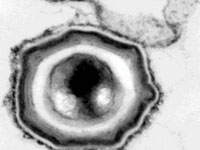生物谷Bioon.com 讯 细菌孢子是地球上最具抵抗性的有机体,而且其携带有额外的蛋白质外层,这是先前的研究所没有发现的。该研究结果发布在最新一期的Current Biology杂志上,这项发现有助于深入理解肉毒杆菌,破伤风杆菌和炭疽杆菌等细菌的生存方式。

这项研究是由纽约大学基因组和系统生物学研究中心,洛约拉大学医学中心和普林斯顿大学分子生物学系的科学家共同完成的。
科研人员以非致病性细菌Bacillus subtilis的孢子作为研究对象,Bacillus subtilis是土壤中一种常见的细菌。尽管它是非致病性的,但Bacillus subtilis存在很多与含有孢子的病原体相同的结构特征。他们对组成孢子保护层的蛋白进行检测,先前的研究主要关注孢子保护层的组成成分,其大约由70种不同的蛋白组成,但几乎没有研究关注这些蛋白在形成孢子保护层过程中的互作机制。
为了研究蛋白之间的互作,研究人员检测了正常孢子和突变孢子外层的形成。在突变的孢子中,他们对所选择的外层蛋白进行基因移除处理,这就使得研究人员能够了解,对于孢子的外衣来说,哪些蛋白是必需的,而哪些蛋白又是无关的。
为了在活体细胞中观察蛋白质的行为,研究人员将编码孢子外衣蛋白的基因绑定到标记物上,标记物是一种绿色荧光蛋白。这一步骤能够检测到蛋白形成孢子保护外衣的过程。通过荧光显微镜实验和高分辨率成像分析技术的结合使用,研究人员建立了一个孢子外层的图谱。实验结果表明在孢子外层上存在着新的外层结构。使用电子显微镜,研究人员能够证实这个新外层的存在。
研究人员将这个孢子的最新外层命名为"孢子壳"(spore crust),但还没有完全确认,这个外层是所有孢子结构细菌的共同特征,比如肉毒杆菌,破伤风杆菌,炭疽杆菌等
这项研究是由美国国家综合医学研究所支持的。
Bioon.com推荐原文出处:
Current Biology doi:10.1016/j.cub.2010.03.060
A Distance-Weighted Interaction Map Reveals a Previously Uncharacterized Layer of the Bacillus subtilis Spore Coat
Peter T. McKenney1, Adam Driks2, Haig A. Eskandarian1, 4, Paul Grabowski1, 5, Jonathan Guberman3, Katherine H. Wang1, 6, Zemer Gitai3 and Patrick Eichenberger1, ,
1 Center for Genomics and Systems Biology, Department of Biology, New York University, New York, NY 10003, USA
2 Department of Microbiology and Immunology, Loyola University Medical Center, Maywood, IL 60153, USA
3 Department of Molecular Biology, Princeton University, Princeton, NJ 08540, USA
Bacillus subtilis spores are encased in a protein assembly called the spore coat that is made up of at least 70 different proteins. Conventional electron microscopy shows the coat to be organized into two distinct layers. Because the coat is about as wide as the theoretical limit of light microscopy, quantitatively measuring the localization of individual coat proteins within the coat is challenging. We used fusions of coat proteins to green fluorescent protein to map genetic dependencies for coat assembly and to define three independent subnetworks of coat proteins. To complement the genetic data, we measured coat protein localization at subpixel resolution and integrated these two data sets to produce a distance-weighted genetic interaction map. Using these data, we predict that the coat comprises at least four spatially distinct layers, including a previously uncharacterized glycoprotein outermost layer that we name the spore crust. We found that crust assembly depends on proteins we predicted to localize to the crust. The crust may be conserved in all Bacillus spores and may play critical functions in the environment.







